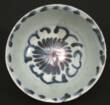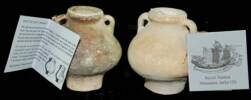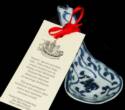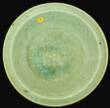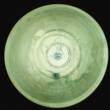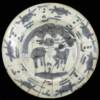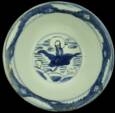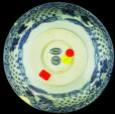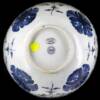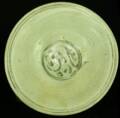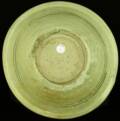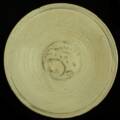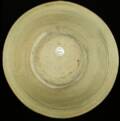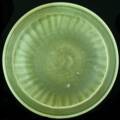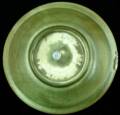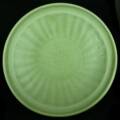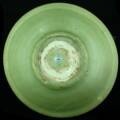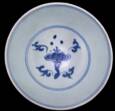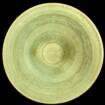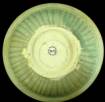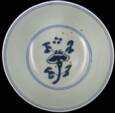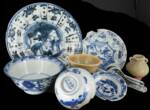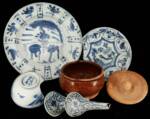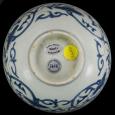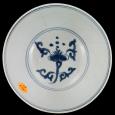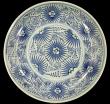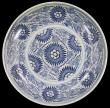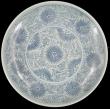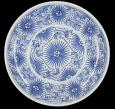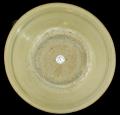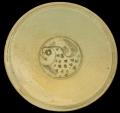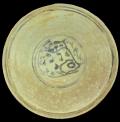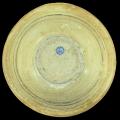Startup set 31
In this set there is a 550 year old celadon bowl and a jarlet from Royal Nanhai (AD. 1460) shipwreck. There is also a blue and white flower bowl and two porcelain spoons from the Desaru (c. 1830) shipwreck. In addition, there is a deer plate, a kraak dish, a small deer saucer and a reign market fisherman bowl from the The Wanli (c. 1625) Shipwreck. This set will be delivered with five Certificate of Authenticity.
640 year old fish and flower plates
Sukhothai fish plates from the Turiang (1370) shipwreck. These plates feature a painted fish (for long life) in the center. Whilst there were numerous fish plates in the Turiang cargo, there were very few flower plates. The flower plates are also very hard to find in the antique market but there are many 'fakes' being made. The technique of painting with iron oxide over a slip layer, is the earliest type of underglaze painting and represents a 1,500 year old Chinese tradition. These plates are VERY RARE. Proper Sukhothai clay is light reddish and always shows white quartz crystals which cannot be seen in modern reproductions. For more information about the underglaze pottery developments and the importance of the Turiang shipwreck which carried this type of historical pottery, click here
MING DYNASTY PORCELAIN from The Wanli (c. 1625) Shipwreck.
The 550 year old celadon wares offered on this page were recovered from the Royal Nanhai (c.AD. 1460) shipwreck site. They are in remarkably good condition despite their long stay on the seabed. The sometime deteriorated glaze was due to iron oxide (from the glaze matrix) which crystallized on the surface and then when in contact with saltwater corroded the glaze. This is yet another provenance factor! The celadon's were made at Ban Ko Noi & Ban Pa Yang, Sisatchanalai, (as can be seen on the video to the left) by immigrating potters from the famous celadon kilns in Longquan China.
For higher quality celadon alternatives,
go to: celadon wares
Chinese blue & white Chrysanthemum bowls from the late Transitional period (AD. c. 1700) wrecksite. These bowls are from a 'wreck site' rather than a shipwreck. It is most likely that the ship hit a nearby reef, punched a hole in its hull, anchored and jettisoned the bowls in order to facilitate repair. All bowls in this group have small rim chips and a few (if noted) show very fine hairlines. All bowls are about 14 cm in diameter. Shipping weight: 07 kilo
Each bowl is delivered with a Certificate of Authenticity.
Sten has spent more than forty years in Southeast Asia designing and engineering various marine structures. His interest in Asia's pottery and porcelain eventually lead to his search and excavation of numbers of ancient shipwrecks. As a championship sailor Sten has extensive knowledge and interest in ancient maritime trade, ships designs and construction. It is these interests and gained knowledge that is the base for all his books and extensive lecturing.
Sten's company; Nanhai Marine Archaeology Sdn. Bhd. works with Malaysia's Department of Museums and Antiquities and can therefore offer legally excavated artifacts from these shipwrecks.
In addition to working with recovering artifacts, Sten has located number of ancient kiln sites in Thailand and in China were his shipwreck ceramics was made centuries ago. He is therefore able to offer absolute provenance on all ceramics sold via Nanhai Marine Archaeology Sdn. Bhd. and, with good conscience sign every Certificate of Authenticity supplied with the artifacts.
The maritime archaeology of Sten Sjostrand has led to major advances in the study of Asian trade and trade ceramics in Southeast Asia. His meticulous documentation of a series of nine shipwrecks from the 11th to 19th centuries reveals the early dominance of Chinese trade ceramics, a subsequent loss of the Chinese monopoly in the late 14th century when Southeast Asian ceramics entered the market, the basic parameters of the Ming gap shortages of the 14th-15th centuries, and a resurgence of Chinese wares in the 16th and 17th centuries. Just as important, Sjostrand freely shares the information from his discoveries. Researchers are welcome at his headquarters where he documents his finds and patiently answers the queries of others. A lifetime’s experience with the sea and sailing allows Sjostrand to bring new understanding to ancient ship construction, and his voluminous reading allows him to set the ships and their cargoes in historical perspective.
Late Dr. Roxanna M. Brown
Director.
Southeast Asian Ceramics Museum
Bangkok University, Rangsit campus
Pathum Thani 12120, Thailand
Antique Chinese porcelain and pottery from Ming dynasty shipwrecks, celadon, antique Chinese porcelain and pottery from well-known shipwreck excavations and other antiques for sale on this site.
All types of Wanli (Ming dynasty) artifacts for sale on this page are depicted and discussed in a catalogue written by this company's principal researcher; Sten Sjostrand. For more details about the catalogue: "The Wanli Shipwreck and its Ceramic Cargo" Click here
This page shows the more affordable ceramic pieces form the shipwreck site. For higher quality pieces, please visit: Wanli: Ming dynasty porcelain wares
Each artifact is delivered with a Certificate of Authenticity.
Tender edges , or as the Japanese more graphically described it, 'moth-eaten' edges is a technical fault in early 17th century porcelain. This effect is seen when the glaze breaks off in patches along sharp edges in a rather irregular manner and particularly common on the rims of bowls, dishes and plates. The cause is complex, but is mainly due to the physical properties of the raw materials and the varying surface tensions of the ingredients of the body and glaze. The fault was overcome in the later part of the 17th century when the potters adjusted the proportions of raw materials.
Tender edges is a commonly acceptable factor for authenticity and should not be mended, as a principle, as it adds to the provenance of the ware. The 'faking' of 'tender edges' is not possible as the edges of the broken off pieces cannot be made as sharp at the original.
These deer plats are made at the famous porcelain center of Jingdezhen, China. Own research at these ancient kiln sites has confirmed that this type of plates was fired at the Guanyinge kilns. These kilns are located just north of the old city zone. The deer's are always depicted below a pine tree. Some of these plates shows the common 'tender edges' which belongs to the period and provide additional authenticity. Due to the firing technique, most of these plates shows sand grits adhering to the foot-ring
To read more about these deer plates and their historical significance, click here
Typical view of the reverse.
All deer plates are about
21-22 cm in diameter
Ser. No. W-1637
A small and nice deer bowl from the Wanli C.1625 shipwreck Contrast of the decoration is good. There is a fine hairline that has been mended and is now totally invisible. The resonance of the bowl is fully restored. The base feature the apocryphal reign mark of emperor Chenghua that ruled China between 1464 -and1487. The bowl will be delivered with a Certificate of Authenticity.
Size: 9 cm diameter
Ser. No. W-555
This Landscape bowl from the Wanli C.1625 shipwreck is plain on the interior. The external sides shows a landscape with a lone scholar. This type of decoration is highly appreciated by Chinese collectors. The glaze is satin and the bowl has a short and fine, now mended hairline. Resonance is fully restored. The bowl will be delivered with a Certificate of Authenticity.
Size: 9 cm diameter
These deer plates shows repeated peach motifs on the cavetto. The peach is the emblem of marriage and symbol of immortality and spring time. The peach is sacred to the Daoists as they believe it grew near the palace of Hi Wang Mu.
The deers are shown below pine trees, which mean 'ever-green throughout the ages' it also convey wishes for life-long vitality and health.
The deer is the emblem of longevity and said to be the only animal able to find the lingzi, the holy fungus of immortality. The deer's are often seen on these deer plates with a fungus between them with a pine tree in the background.
The pine tree is known for its endurance. So together with the deer and the fungus, the plates express wishes for a long, prosperous and healthy life.
FREE:
Every deer plate will be delivered with two Qing dynasty porcelain spoons from the Desaru
(AD. 1830) shipwreck.
Ser. No. W-468
An intact plate of good quality with well executed and contrasty decoration. High pitch sound is heard when the plate is tapped. The rim is free from 'tender edges. The plate will be delivered with a Certificate of Authenticity
Shipping weight: 1.0 kilo
REST ASSURED OF PROPER AUTHENTICITY
When ordering from these pages you are dealing directly with a team of dedicated researchers that excavated, recovered and researched every single artifact offered for sale. We encourage you to contact our Sten Sjostrand with any questions which you may have
OUR GUARANTEE:
If you are not satisfied with our artifacts, delivery service or; if you obtain an expert opinion
that a delivered item is not of the age stated by us, just return it and we will issue full refund.
Celadon bowls from the Royal Nanhai (1460) shipwreck. These bowls are intact but shows different degree of glaze wear. They are made at Sisatchanalai by Chinese potters whom were active in the area between the 14th and 16th century. Each bowl will be delivered with
Ser. No. RN-122
Good bowl which shows thick glaze covering. There is a very small (5mm) rim fill which is hard to see.
Size: 14.5 cm diameter
Shipping weight: 0.8 kilo
TR-535 Flower bowl with contrasty blue decoration. There is however a short, fine hairline and a small chip at the mouth rim
THE ONLY PLACE WHERE YOU CAN BE SURE TO BUY GENUINE ANTIQUES
Nanhai Marine Archaeology Sdn. Bhd. was incorporated on the recommendation of the Malaysian authorities. This was done in order to formalize and to expand on the company’s researcher’s extensive knowledge of Asia’s ceramic developments and maritime trade.
The company’s researchers have been engaged in the search for historical shipwrecks for more than three decades and another decade researching maritime trade. Most of this work is concentrated to the South China Sea, a virtual highway for ancient shipping linking China to India, the Middle East and Southeast Asia in an extensive maritime trade system. This ancient trade started sometime around the 4th century and lasted well into the 19th century.
Following a successful shipwreck discovery, the company obtain a government permit to excavate the wreckage, and then carry out detailed marine archaeological procedures in recovering the artifacts, mapping the ship's remains and securing other data for future research. After each concluded project and following conservation of recovered artifacts, we search for and pinpoint ruined kiln sites and compare its wasters with the recovered ceramics until we are satisfied we located the place in which the shipwreck pottery was made centuries earlier.
As such we have precisely located a kiln sites in Sisatchanalai, northern Thailand in which our Royal Nanhai and the Nanyang shipwreck celadon ware was made around AD. 1380-1460. (See videos on: http://www.ming-wrecks.com/photopage.html ) Other kilns was located in Sukhothai where production wasters matched the fish and flower plates found on the Turiang and the Longquan shipwreck. These unique underglaze decorated wares was made at those exact kilns 600 years earlier! Our latest shipwreck cargo; The Wanli Shipwreck, of Chinese blue and white porcelain, was likewise pinpointed to the Guangyinge kiln site in Jingdezhen, China. (See video on: http://www.ming-wrecks.com/photopage.html )
Our arrangement with the Malaysian authorities is such that we finance all operations and train young Malaysian nationals (on our initiative) in maritime archaeology and related research. After giving all unique and single artifacts and thirty percent of all recovered items to the National Museum (and assisting with exhibitions of artifacts from each project) we are allowed to sell our portion of the recovery to finance future projects. The findings from ongoing research and the compilation of reports, books and catalogues are available on these pages as well as on a separate Internet site: http://www.maritimeasia.ws
Due to the unquestionable authenticity and precisely dated shipwreck pottery, many International Museums now display our shipwreck pieces as reference material.
The artifacts sold on this website are therefore legally and properly excavated and can be supplied with an export permit from the Department of Museum in Malaysia should this be required. This unique working arrangement makes us one of the few Internet sellers that sell from own excavation and issues a meaningful Certificate of Authenticity for every piece with a serial number.
So, if you are interested to purchase some of our Antique porcelain, old time pottery or other shipwreck artifacts from the Song dynasty, Ming porcelain or Chinese blue and white porcelain or the famous Yixing teapots, you can rest assured that every piece is excavated through proper archaeology by our own staff. We do not sell anything that is not excavated by ourselves or properly recorded and researched before offered for sale so every piece comes with the “Best possible provenance”
WE ENCOURAGE YOU TO EMAIL OUR PRINCIPAL RESEARCHER; Sten Sjostrand SHOULD YOU HAVE ANY QUESTIONS ABOUT YOUR POSSIBLE PURCHASE
TR-461 Flower bowl with good glaze and contrasty decorations. There is only a small chip on the rim. Low resonance.
TR-325 Flower bowl with contrasty decorations. Very small chip at the rim. The bowl is otherwise fine and a good purchase consider its age.
Ser. No. W-6045
Intact plate with high contrast decorations. There is however a small (original) dray crack in the center of the plate. It will be delivered with a Certificate of Authenticity
Shipping weight: 1.0 kilo
Ser. No. W-3754
Nice intact plate with with well executed decoration. By using a rich mixture of cobalt oxide, the potter achieved high concentration of the blue. This is clearly seen in this plate. The plate will be delivered with a Certificate of Authenticity Shipping weight: 1.0 kilo
TR-515 Flower bow with nice 'soft' decorations. There is one fine (now mended) hairlines. Resonance is low.
The Chrysanthemum is the emblem of Autumn and steadfast friendship and is associated with life of ease and retirement
Ser. No. W-71
Nicely decorated and intact deer plate with good, contrasty decoration and high concentration of cobalt oxide. The plate has good high pitch resonance sound when tapped One of thed best deep plate from the Wanli cargo. To be delivered with a Certificate of Authenticity
Shipping weight:1.0 kilo
TR-512 Flower bowl with nice contrasty and well executed decoration. Only small chips on the rim. Low resonance.
TR-374 Flower bowl. The bowl is intact but has a now mended fine hairline. with only two small rim chip. Decoration is otherwise nicely executed.
Bowls from the 550 years old Royal Nanhai (AD. 1460) shipwreck
Ser. No. RN-88 A nice bowl with soft, thick, exterior glaze surface. There is however some glaze deterioration in the well. There is an very small, hard to see, rim fill.
Shipping weight: 0.5 kilo
Size: 11 cm diameter
Ser. No. W-4652
Nice scholar bowl in a reasonable good condition. Rendering is well done with a contrasty cobalt oxide. There is a hard to see fine hairline in the center of picture "aa". Despite this, the resonance sound when tapped is very good. Glaze covering is thick and semi-satin. The bowl will be delivered with a Certificate of Authenticity.
Size: 9 cm diameter
Ser. No. W-4699
Nice fungus bowl with contrasty decoration and very high pitch resonance coming from good clay quality and high firing temperature.The bowl has a mended hairline which is hard to see and a short, shallow rim fill. Delivered with a Certificate of Authenticity.
Size: 14.5 cm diameter
This type of celadon bowls has deteriorated to various degree during their centuries long stay on the seabed. This deterioration is due to undisolved (low-fired) iron oxides in the glaze matrix. Each artifact is hand made and therefore individual in size, shape and quality. Ordered artifacts may therefore be slightly different from the one shown. We do however assure you that the general appearance (and authenticity) is comparable whilst we will attempt to send items of no lesser quality than that seen on the pictures to the left.
Ser. No. W-3626
A nice, intact, fungus bowl with a smooth rim and free from 'tender edges' Overall, this is a very good bowl but shows two fine, now mended hairlines. Decorations are well executed in high contrasty cobalt oxide.
The bowl will be delivered with a Certificate of Authenticity.
Shipping weight: 0.7 kilo
Size: 14 cm diameter
Kraak dishes from The Wanli (c. 1625) Shipwreck.
By painting a bird on a rock below a flower arrangement on these kraak dishes, the artist convey the meaning of chun guang chang shou which refers to 'spring time and longevity' to the Chinese. All this together connotes the blessing for vibrant youth, healthiness and long life. The dishes are more than likely made at the Guangyinge kiln complex, Jindezhen, China, where Sten Sjostrand, our principal researcher, located production waster similar to these samples. These dishes will be delivered with a Certificate of Authenticity
Ser. No. T-1060
A 640 year old Chinese celadon plate from the Turiang (1370) shipwreck. The plate is made at the famous celadon kilns in Longquan, China.The plate is intact and provide a high pitch resonance sound when taped. This, suggest a very high firing temperature. Glaze covering is thick and satin. The plate will be delivered with a Certificate of Authenticity.
Size: 25.5 cm in diameter
Shipping weight: 2.5 kilo
Ser. No. RN-3493
Nice and totally intact celadon dish from the Royal Nanhai (AD. 1460) shipwreck. It shows an incised 'coma' pattern of the cavetto and a concentric circle in the base. The reverse is decorated by vertical striations. There are some minor glaze wear along the rim. This dish was made at the Sisatchanalai kilns by immigrating Chinese potters, arriving from the famous celadon potteries in Longquan -China. The dish will be delivered with a Certificate of Authenticity.
Size: 23.5 cm diameter
Shipping weight: 2.35 kilo
Ser. No. RN-3061
Another affordable celadon dish from the Royal Nanhai (AD. 1460) shipwreck. This dish shows incised 'coma pattern' and a wave band on the border. The base shows a well developed 'tubular' support scar The overall appearance is good and the glaze condition is satin, thick and better than most dishes in the Royal Nanhai cargo. There is small, hard to see, but now mended crack as indicated. The dish will be delivered with a Certificate of Authenticity.
Size: 22.5 cm diameter
Ser. No. D-22509
A totally intact flower dish from the Desaru shipwreck Its show good glaze condition and 'soft style' cobalt oxide decorations. The dish gives a high pitch sound when tapped. The dish will be delivered with a Certificate of Authenticity
Size: 27 cm diameter
Shipping weight: 1.5 kilo
Ser. No. T- 570
Totally intact underglaze decorated fish plate from the Turiang (1370) shipwreck This is one of very few plates where the fish motif faces right. The plate will be delivered with a Certificate of Authenticity.
Size: 23 cm in dia
Weight: 1.5 kilo
Ser. No. T-145
This underglaze decorated fish plate is one of the best samples recovered from the Turiang (1370) shipwreck.The plate is totally intact and show a high gloss glaze surface and contrasty motif. It will be delivered with a Certificate of Authenticity.
Size: 25 cm dia
Weight: 1.5 kilo
The discovery of the Royal Nanhai (c. AD.1460) shipwreck. Click to see the site before excavation
Pinpointing the kiln site where the Royal Nanhai celadon wares was made 550 year ago
Celadon bowls from the Royal Nanhai (AD. c. 1460) shipwreck These bowls are intact and shows reasonable good celadon glaze surfaces. Each of these bowls will be delivered with a Certificate of Authenticity.
Ser. No. RN-809
Intact good bowl with vertical striation on the exterior. There is limited glaze separation in the well of the bowl. Otherwise the bowl is in good condition.
Size: 11.5 cm dia
Shipping weight: 0.5 kilo
Ser. No. RN-756
This bowl is totally intact and show very good glaze remains. Delivered with a Certificate of Authenticity.
Size: 9 cm dia
Shipping weight: 0.4 kilo
Ser. No. RN-333
Very nice intact bowl with vertical striations on the exterior. Glaze condition is reasonably good. Delivered with a Certificate of Authenticity.
Shipping weight: 0.5 kilo
Size: 11.5 cm dia.
Ser. No. T-548
This underglaze decorated fish plate show nice and soft decoration. The plte shows good and thick glaze remains. There is a small, hard to see, rim chip at 12 o'clock. It will be delivered with a Certificate of Authenticity.
Size: 25 cm dia
Weight: 1.5 kilo
Ser. No. T- 18
This fish plate from the Turiang (1370) shipwreck. The plate is intact and feature thick and glossy glaze. There is however some glaze deterioration at about 6 o'clock. To be delivered with a Certificate of Authenticity.
Size: 23.5 cm in diameter
Weight: 1.5 kilo
Ser. No. RN-107 11 cm dia.
Very good glaze condition but a small rim repair
Shipping weight: 0.4 kilo
Celadon bowls from the Royal Nanhai (1460) shipwreck. These bowls are intact unless otherwise stated but shows different degree of glaze wear. They are made at Sisatchanalai by Chinese potters whom were active in the area between the 14th and 16th century. Each bowl will be delivered with a Certificate of Authenticity.
Ser. No. RN-380 Size: 11.5 cm diameter
Intact bowl with light glaze deterioration. The cavetto shows a unsusual 'onion skin' decoration. The exterior is plain.
Size: 13 cm diameter
Shipping weight: 0.5 kilo
Like to collect but don't know where to start?
Here are two sets put together by our Sten Sjostrand which includes historical artifacts of varying age and from different shipwrecks. In these sets there may be some minor chips or flaws on some of the pieces.
Ming dynasty fungus decorated bowls from The Wanli (c. 1625) Shipwreck
The glossy ganoderma or Linzhi fungus, is a plant with medicinal values and a symbol for longevity. It is often seen together with the deer as the deer is the only animal which can find the sacred fungus. These bowls also shows a fungus motif in the well.
Ser. No. W-7482
An intact kraak dish with rounded sides. It was recovered from the Wanli C.1625 shipwreck). The dish is decorated in contrasty colors with a artemisia leave, tassel and ribbons which together express wishes for long life, prosperity and health.This theme was immensely popular during the Ming dynasty. The dish will be delivered with a Certificate of Authenticity
Size: 15 cm diameter
Ser. No. W-04
A good intact plate with contrasty decoration and well executed rendering. The glaze surface is very high gloss. Good resonance sound when tapped. It will be delivered with a Certificate of Authenticity
Shipping weight: 1.0 kilo
Ser. No. W-902
A good quality plate with contrasty and well executed decoration. Resonance of the plate when tapped is good. The glaze is high gloss. There is (as there should be) sand grit on the reverse around the foot-ring. This is evidence of the firing technique used for this type of plates. The plate will be delivered with a Certificate of Authenticity
Shipping weight: 1.0 kilo
The Wanli shipwreck (AD. 1625) deer plates
These deer plates have an interesting part in the Inter Asia trade as well as in the spice trade with Europe. It is a well-known fact that most ships carrying ceramics from China (mostly destined for Europe) would offload their cargo in transshipment ports like Melaka, Malaysia or in Batavia, Indonesia. These two ports were the most important centers for the 17th and 18th century Portuguese and Dutch trade.
At these two ports most deer plates would be offloaded and then sent to Molluccas (the Spice Islands in the eastern part of Indonesia) with local ships to be traded for spices. Once the spices were back in the respective transshipment ports, it would be sent to Europe. It is for that reason that we find very few deer plates reaching the European markets. So, had the Wanli shipwreck (Portuguese private trader) been found after reaching Melaka (in its way to Goa, India) there would be little if any deer plates onboard. As such we would have little idea about the quantities of trade goods going to Molluccas.
Since the Wanli shipwreck was lost off the Malaysian east coast, before reaching Melaka, we are able to see all the different types of porcelain as it was when the ship loaded in China. These deer plates are therefore important historical artifacts telling us about ancient trade and its routing and quantities.
Reserve painted peony dishes
These RARE, (reserve painted) peony dishes are special in the way they are painted. Instead of filling in cobalt blue insider the darker outlines, the decorator filled in the area outside the outline and thereby colored the background rather than the motif itself. As such the motif is white whilst it is 'normal' to have a blue motif. The peony is the queen of flowers and the flower of riches and honor. It symbolizes wealth and distinction.
Ser. No. W-4969
A beautiful and RARE peony dish with high contrast decoration and a well executed motif. Glaze condition is very good. There is however two fine, now mended and hard to see, hairline in the cavetto.
To be delivered with a
Size: 21 cm dia
Shipping weight: 0.85 kilo
Ser. No. W-7033
A very good dish showing the bird on the rock. This dish has very high pitch sound when tapped which suggest high firing temperature. The dish does however has a short, original, dry crack at 11 o'clock *
There are no tender edges' and the rim is smooth.
Size: 15 cm dia
To be delivered with a
Ser. No. W-1653
This dish has good, high pitch sound when tapped and shows well executed and contrasty decorations. There is however a fine, hard to see, hairline.
The motifs which include the tassel, a scroll and ribbons which together express wishes for long life, prosperity and health
Size: 14.5 cm dia
To be delivered with a
 | ||||
CLICK ON BELOW IMAGES TO VIEW OUR SALES PAGES
These fish decorated plates are RARE & important historical artefact. To read more about their origin and developments, click here
Ser. No. T-815
A 640 year old Chinese celadon plate from the Turiang (1370) shipwreck. The plate is made at the famous celadon kilns in Longquan, China. Glaze condition is thick and satin. When tapped, the plate provide a high pitch sound suggesting high firing temperature. The plate will be delivered with a Certificate of Authenticity.
Size: 23.5 cm in diameter
Shipping weight: 2.5 kilo
Royal Nanhai Jarlets (c. 1460)
These 550 year old celadon bottles have lost most of their glaze due to the long stay on the seabed. Their low-fired celadon glaze consists of 1.2 - 1.5 % iron oxides that turn green during reduction-atmosphere firing. If sufficient temperature was not achieved, the iron oxide would accumulate on the surface in the form of iron crystals. From prolonged contact with salt water, the crystals will corrode and slowly age the surface. Despite glaze deterioration, they still show a unique form of an ancient "medicine" bottle. For more information: Royal Nanhai (AD. c. 1460) shipwreck
Tall Celadon Jarlet About 6 cm high
Two round celadon Jarlets. About 6 cm high
Desaru porcelain spoons (c. 1830)
These delicate blue & white spoons are of slightly different shape/quality as they are individually crafted.
It is likely that these spoons were to be sold by Mr. Sin Guan Hup, whose seal stamp was found on the wreck site. For more information: Desaru (c. AD. 1830) shipwreck
One porcelain spoon About 10.5 cm long
 | ||||
OTHER WEB PAGES RELATED TO ANTIQUE CELADON, CHINESE PORCELAIN,
SHIPWRECK POTTERY AND ANTIQUES FOR SALE
Click here to add text.
We are PayPal Verified
for safe Online payments
Ser. No. D-169
Another nice flower dish from the Desaru shipwreck. The glaze condition is high gloss. The resonance of the dish is high pitch . There is a (now mended) fine hairline that is near impossible to see.The dish will be delivered with a Certificate of Authenticity
Size: 27 cm diameter
Shipping weight: 1.5 kilo
Small bowls from The Wanli (c. 1625) Shipwreck
(The post office has a minimum shipping charge of 1 Kilo. You may therefore add a second, lighter, artifact to your order without additional cost.)
CNanhai Marine Archaeology Sdn. Bhd.
Large Flower Bowls from the Ming dynasty
These large flower bowls from the Ming dynasty Wanli C.1625 shipwreck are hardly ever seen in the antique markets. They show four unusual floral roundels separated by a lotus scroll. The interior is finished with another floral roundel in the well and a high border with palm trees, pagoda, landscape and small boat motifs. The bowls sometimes shows the apocryphal reign mark of emperor Chenghua (1464 - 1487) and sometimes the blue circles only. Very RARE is the use of bi-style foot-ring which, due to its width never include reign marks.
The motifs on this flower bowl are well
executed and painted in contrasty cobalt oxide.
Inner border show willow trees, pagodas
and a seascape. Glaze surface is good and
glossy. The bowl has two, now mended, fine hairlines and a minor rim fill. The resonance sound of the bowl when tapped if high pitch. The base is plain.
The bowl will be delivered with a Certificate of Authenticity.
Ser. No. W-4009
Size: 22 cm diameter
The flower motifs on this bowl are nicely
executed and in strong contrasty cobalt blue.
Inner border is high and featuring
willow trees, pagodas and fisherman
in a seascape. The glaze covering is very
good and show a high glossy surface.
The bowl is intact exept for a, now mended, fine hairline. The resonance when tapped is very high pitch. The bowl will be delivered with a
Ser. No. W-101
Size: 22 cm diameter
Large Character Bowl from the Ming dynasty
This RARE and much south after character bowl from the Wanli C.1625 shipwreck depicts Shou Lao, the God of longevity, riding a crane above crested waves in the well. The exterior decoration feature four medallions, each depicting two of the Eight Immortals, surrounded by repeated shou (longevity) characters. This repeated use of the the shou character is known as Bai Shou Tu in Chinese, meaning the 'Picture of One Hundred shou characters' and is very common in Chinese traditional work of art. These bowls are traditionally an excellent gift as they provide wishes for long life. The Eight Immortals are the favorite pantheon in Daoism.
Character bowl W-1024 is well made with all decorations perfectly executed and in soft cobalt colors. This bowl has a visible rim repair but provide a very high pitch sound when tapped. The rim repair can hardly be seen from the top of the bowl. The high pitch sound suggest good clay and very high firing temperature. The foot ring is of the 'bi-style' type which is highly unusual. The bowl will be delivered with a Certificate of Authenticity The diameter of the bowl is 22 centimeter.
Ser. No. W-1024
Shipping weight: 1.75 kilo
Ser. No. W-735
A highly stylized squirrel and grape vine bowl from the Wanli C.1625 shipwreck. The bowl is totally intact with a 'soft' tone decoartion. The bowl will be delivered with a Certificate of Authenticity.
Size: 11.5 cm diameter
Ser. No. W-2006
A RARE and nice peony dish with high contrast decoration and a well executed motif. Glaze condition is thick and glossy. There is however two fine, mended hairlines, which are hard to see, in the cavetto.
To be delivered with a
Size: 21 cm dia
Shipping weight: 0.85 kilo
Startup set 32
In this set there is a 550 year old stoneware lid from the Royal Nanhai (AD. 1460) shipwreck. There is also two porcelain spoons, a brown-glazed jar from the Desaru (c. 1830) shipwreck. In addition, there is a deer plate, a chipped kraak dish and a small reign marked landscape bowl from the The Wanli (c. 1625) Shipwreck This set will be delivered with three separate Certificate of Authenticity
aa
Ser. No. D-22577
A very nice intact flower dish from the Desaru shipwreck It show good glaze condition and contrasty decorations. The dish gives extremely high pitch sound when tapped. There is a very small original dry crack at about 6 o'clock. This 'crack' which is a contraction of the clay when firing. This will not cause any damade to the dish in the dfuture. To be delivered with a Certificate of Authenticity
Size: 26 cm diameter
Shipping weight: 1.5 kilo
Ser. No. D-52146
Another intact flower dish from the Desaru shipwreck. The glaze condition is high gloss. The painting is high contrast but there are some glaze void in the well and the rim. To be delivered with a Certificate of Authenticity
Size: 26.5 cm diameter
Shipping weight: 1.5 kilo
Click here to add text.
* this crack can be filled if the buyer request.add text.
These kraak plates were recovered from the The Wanli (c. 1625) Shipwreck and are best dated to
AD. 1625.
The painted motifs from this time is usually an bird or an insect sitting on a rock (the rock of longevity) and placed below a flower arrangement. These motifs express wishes for a long life which, to the Chinese means: chum gung Chang shout referring to the theme: 'spring time and longevity'. All this together connotes blessings for vibrant youth and healthiness and long life.
Whilst the samples offered on this page are not the best quality wares from the wreck site, they are near 400 years old and without any question about authenticity. Each plate will be delivered with a Certificate of Authenticity
Ser. No. W-6638,
Kraak plate. Totally intact except for a very shallow, hard to see, rim fill at 9 o'clock.
21.5 cm in diameter
Ser. No. W-163,
Kraak plate with rare grasshopper. Totally intact except for one short mended hairline.
21 cm in diameter
SOLD OUT
Ser. No. W-127
Nice plate with high contrast decorations and high gloss glaze surface. There is however a small rim chip at about 7 o'clock. The plate will be delivered with a Certificate of Authenticity
Shipping weight: 1.0 kilo


